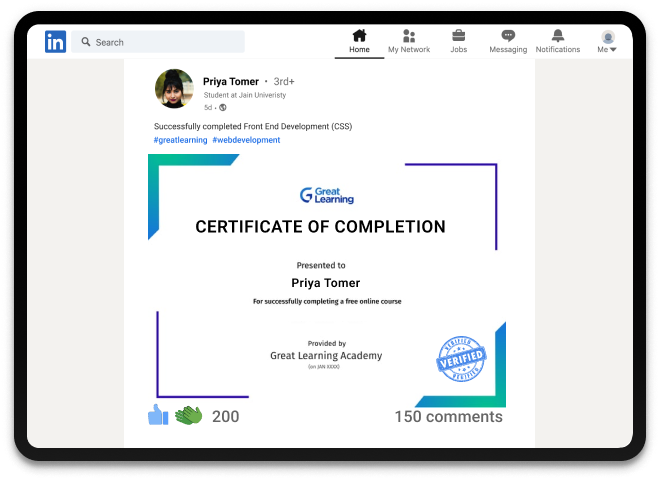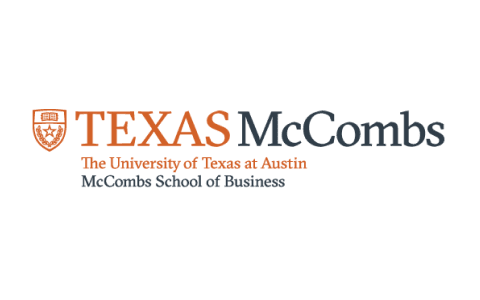
Outside USA: +1‑607‑330‑3200

Hypothesis Testing Cornell Course
Course overview.
Basic statistical tools provide a starting point, but when it comes to tackling complex business scenarios, you often need more. Making informed decisions frequently requires the ability to devise and test hypotheses.
In this course, you will practice creating and testing hypotheses. You will examine how to construct a hypothesis that is rigorous and testable and test your hypotheses using different types of statistical data. Combining this skillset with your foundations in statistics and probability, you will enhance your understanding of potential outcomes. By the end of this course, you will be equipped with the skills necessary to back up business decisions with solid mathematical justification and foster improved communication about your decisions and with your stakeholders.
You are required to have completed the following courses or have equivalent experience before taking this course:
- Data Analysis and Probability
- Decision Analysis
- Continuous Distributions
Key Course Takeaways
- Examine how to construct a hypothesis that is rigorous and testable
- Test hypotheses using different types of statistical data

How It Works
Course author.

- Certificates Authored
Dr. David C. Juran, who teaches courses in statistics for management and managing operations, is a winner of six teaching awards at Columbia Business School and at the Cornell Johnson Graduate School of Management, including the EMBA Globe Award for Teaching Excellence. Juran’s research has appeared in Management Science, Journal of Operations Management, and other journals. Juran’s academic interests are informed by extensive industrial and corporate experience at Pepperidge Farm, Spaulding Company, and Juran Institute, as well as his experience as an independent management consultant for organizations such as [x+1], Gordian Group, Johnson & Johnson, MarketBridge, MTV Networks, Opera Solutions, Veeco, and Carl Zeiss. Dr. Juran earned his Ph.D. at Cornell University’s Johnson Graduate School of Management, concentrating in the fields of operations management, operations research, and organizational behavior.
- Applied Statistics
Who Should Enroll
- Professionals looking to uncover insights from data
- Students who are pre-MBA or considering earning an MBA
- Analysts and researchers
- Individuals interested in moving into an analyst role
- Anyone seeking to leverage statistical or analytic skills
Stack To A Certificate
Request information now by completing the form below..
Enter your information to get access to a virtual open house with the eCornell team to get your questions answered live.
Grokking GenAI: 9 Unique Ways

9 Weird & Wonderful Ways to Grok Generative AI and Large Language Models
A human neural network trained on Anime subtitles was used to generate this article.
- 9 Best Free LaTeX Courses for 2024
- 7 Best SAS Courses for 2024: Robust Data Analytics
- Stanford Medicine Offers Courses with Free Certificate & CME Credit
- 5 Best Free Web Development Courses for 2024: Over 900 Hours of Learning
- 5 Best Notion Courses for 2024: Boost Your Productivity
600 Free Google Certifications
Most common
- computer science
Popular subjects
Graphic Design
Management & Leadership
Artificial Intelligence
Popular courses
What is a Mind?
Divide and Conquer, Sorting and Searching, and Randomized Algorithms
Best Practices for Biomedical Research Data Management (HE)
Organize and share your learning with Class Central Lists.
View our Lists Showcase
Class Central is learner-supported. When you buy through links on our site, we may earn an affiliate commission.
Statistical Inference and Hypothesis Testing in Data Science Applications
University of Colorado Boulder via Coursera Help
- Learn How to Sign up to Coursera courses for free
- 1700 Coursera Courses That Are Still Completely Free
- Start Here!
- Welcome to the course! This module contains logistical information to get you started!
- Fundamental Concepts of Hypothesis Testing
- In this module, we will define a hypothesis test and develop the intuition behind designing a test. We will learn the language of hypothesis testing, which includes definitions of a null hypothesis, an alternative hypothesis, and the level of significance of a test. We will walk through a very simple test.
- Composite Tests, Power Functions, and P-Values
- In this module, we will expand the lessons of Module 1 to composite hypotheses for both one and two-tailed tests. We will define the “power function” for a test and discuss its interpretation and how it can lead to the idea of a “uniformly most powerful” test. We will discuss and interpret “p-values” as an alternate approach to hypothesis testing.
- t-Tests and Two-Sample Tests
- In this module, we will learn about the chi-squared and t distributions and their relationships to sampling distributions. We will learn to identify when hypothesis tests based on these distributions are appropriate. We will review the concept of sample variance and derive the “t-test”. Additionally, we will derive our first two-sample test and apply it to make some decisions about real data.
- Beyond Normality
- In this module, we will consider some problems where the assumption of an underlying normal distribution is not appropriate and will expand our ability to construct hypothesis tests for this case. We will define the concept of a “uniformly most powerful” (UMP) test, whether or not such a test exists for specific problems, and we will revisit some of our earlier tests from Modules 1 and 2 through the UMP lens. We will also introduce the F-distribution and its role in testing whether or not two population variances are equal.
- Likelihood Ratio Tests and Chi-Squared Tests
- In this module, we develop a formal approach to hypothesis testing, based on a “likelihood ratio” that can be more generally applied than any of the tests we have discussed so far. We will pay special attention to the large sample properties of the likelihood ratio, especially Wilks’ Theorem, that will allow us to come up with approximate (but easy) tests when we have a large sample size. We will close the course with two chi-squared tests that can be used to test whether the distributional assumptions we have been making throughout this course are valid.
Jem Corcoran
- united states
Related Courses
Data science foundations: statistical inference, statistical inference for estimation in data science, managing, describing, and analyzing data, anova and experimental design, modern regression analysis in r, stability and capability in quality improvement, related articles, 10 best data science courses, 1700 coursera courses that are still completely free, 250 top free coursera courses of all time, massive list of mooc-based microcredentials.
4.8 rating at Coursera based on 40 ratings
Select rating
Start your review of Statistical Inference and Hypothesis Testing in Data Science Applications
Never Stop Learning.
Get personalized course recommendations, track subjects and courses with reminders, and more.
- Subscription
Hypothesis Testing in Python
In this course, you’ll learn advanced statistical concepts like significance testing and multi-category chi-square testing, which will help you perform more powerful and robust data analysis.
Part of the Data Analyst (Python) , and Data Scientist (Python) paths.
- Intermediate friendly

“Dataquest teaches you how you do data analysis in the real world. Dataquest is well-suited for folks with busier schedules. The lessons are broken into smaller chunks, so it’s really conducive to that. You only have an hour, okay, well, just do one or two lessons and that’s fine.”
Stacey Ustian
Course overview.
In this course, you’ll learn about single and multi-category chi-square tests, degrees of freedom, hypothesis testing, and different statistical distributions.
To learn about hypothesis testing and statistical significance, you’ll work hands-on with multiple datasets on weight loss data — are patients losing weight due to pure luck, or is it a diet pill? You’ll run the numbers and find out!
At the end of the course, you’ll complete a guided project in which you’ll work with data from the American TV show Jeopardy. You’ll analyze text and search for winning strategies. It’s a chance for you to combine the skills you learned in this course, and to showcase a fascinating project in your portfolio. Best of all, you’ll learn by doing — you’ll practice and get feedback directly in the browser.
- Defining regular and multi-category chi-squared tests
- Performing significance testing to understand an outcome's importance
Course outline
Hypothesis testing in python [4 lessons], significance testing 1h.
- Explain how hypothesis testing works
- Define the relation between statistical significance and hypothesis testing
Chi-Squared Tests 1h
- Determine the statistical significance of a set of categorical values
- Generate the chi-squared distribution
- Define degrees of freedom
Multi-Category Chi-Squared Tests 1h
- Extend chi-squared tests to multiple categories
- Calculate the statistical significance of multi-category chi-squared tests
Guided Project: Winning Jeopardy 1h
- Answer questions using text data
- Apply chi-squared tests to real problems
Projects in this course
Guided project: winning jeopardy.
For this project, you’ll take on the role of a Jeopardy contestant looking for any edge to win. You’ll work with a dataset of 20,000 Jeopardy questions using Python and pandas to analyze question and answer text and uncover helpful patterns.
The Dataquest guarantee
Dataquest has helped thousands of people start new careers in data. If you put in the work and follow our path, you’ll master data skills and grow your career.
We believe so strongly in our paths that we offer a full satisfaction guarantee. If you complete a career path on Dataquest and aren’t satisfied with your outcome, we’ll give you a refund.
Master skills faster with Dataquest
Go from zero to job-ready.
Learn exactly what you need to achieve your goal. Don’t waste time on unrelated lessons.
Build your project portfolio
Build confidence with our in-depth projects, and show off your data skills.
Challenge yourself with exercises
Work with real data from day one with interactive lessons and hands-on exercises.
Showcase your path certification
Share the evidence of your hard work with your network and potential employers.
Grow your career with Dataquest.

Aaron Melton
Business analyst at aditi consulting.
“Dataquest starts at the most basic level, so a beginner can understand the concepts. I tried learning to code before, using Codecademy and Coursera. I struggled because I had no background in coding, and I was spending a lot of time Googling. Dataquest helped me actually learn.”

Machine Learning Engineer at Twitter
“I liked the interactive environment on Dataquest. The material was clear and well organized. I spent more time practicing then watching videos and it made me want to keep learning.”

Victoria E. Guzik
Associate data scientist at callisto media.
“I really love learning on Dataquest. I looked into a couple of other options and I found that they were much too handhold-y and fill in the blank relative to Dataquest’s method. The projects on Dataquest were key to getting my job. I doubled my income!”
Join 1M+ data learners on Dataquest.
Create a free account, choose a learning path, complete exercises and projects, advance your career, start learning today.
Welcome Back!
It looks like you already have created an account in GreatLearning with email . Would you like to link your Google account?
1000+ Courses for Free
Forgot password
If an account with this email id exists, you will receive instructions to reset your password.
Explore 1000+ Free Courses
Provide email consent.
Kindly provide email consent to receive detailed information about our offerings.
Have an account?
Email us at [email protected] to stop receiving future communication.
By signing up/logging in, you agree to our Terms and condition • Privacy Policy
We've sent an OTP to CHANGE
- Great Learning
- Free Courses
- Data Science
Hypothesis Testing
Get familiar with the significant concept of Hypothesis Testing through this free online course. Learn types of errors, Z-test, T-test, sample, and population. Enroll and learn Hypothesis Testing in detail with the hands-on demo.
Certificate of completion
Presented to
For successfully completing a free online course
Provided by
Great Learning Academy
(on JAN XXXX)
What you learn in Hypothesis Testing ?
About this Free Certificate Course
This free Hypothesis Testing course will help you comprehend the major concepts that help to carry it out successfully. You will learn about Type 1 & 2 errors and understand the Z-test in detail. You will learn about the Student’s T-test where you will go through types of T-tests, and their uses, and solve real-world examples to understand them better. You will further understand random sample and population size and their role in Hypothesis Testing. Lastly, you will learn independent T-test two sample and T-test outcome and paired T-test for student’s score. You will solve real-world examples along with a hands-on demo through which you will also gain the required practical knowledge. Complete the modules and a quiz to earn a free certificate of Hypothesis Testing course completion certificate.
Check out Great Learning’s Best Data Science Courses to gain in-depth knowledge in this field and earn the certificate that helps you grab better job opportunities.
Premium programs from top universities
Make the right decision for your career growth today!
- Course Outline
This module discusses the important concept of hypothesis testing: type 1 and type 2 errors. You will go through them in detail and understand the various assumptions concerned along with solving a Z test result-related problem.
In this module, you will learn about the T-test from scratch. You will understand its uses, types, and solve an example to gain practical knowledge.
This module introduces you to the important terms in hypothesis testing called sample and population. You will understand how random sample and population size plays role in hypothesis testing.
This module in detail explains to you about independent T-test two sample and T-test outcome. You will go through a hands-on demo to understand how code works in each case.
In this module, you will go through an example where you will apply paired T-test for student scores and understand the implementation of the test and carry out the hypothesis testing.
Share your certificate & get noticed
Showcase your skills
Gain a competitive edge
Stand out to recruiters
Land your dream job

What our learners say about the course
Find out how our platform helped our learners to upskill in their career.
With this course, you get
Free lifetime access
Learn anytime, anywhere
Completion Certificate
Stand out to your professional network
of self-paced video lectures
Share with friends
UPGRADE Post Graduate Programs from Top Universities
Frequently Asked Questions
What are the prerequisites required to learn this free Hypothesis Testing course?
This Hypothesis Testing course is suitable for beginners, so there are no prerequisites for enrollment.
How long does it take to complete this free Hypothesis Testing course?
There are two hours of self-paced video content in this course that learners can learn at their own pace and comfort.
Will I have lifetime access to the free course?
Yes, you can access any of the Great Learning Academy’s free courses at your preferred period and resume learning.
What are my next learning options after this Hypothesis Testing course?
You can go through Great Learning’s PG Data Science and Machine Learning Course by MIT.
Is it worth learning about Hypothesis Testing?
Yes, hypothesis testing is a useful tool for determining whether a claim is supported by evidence. It can help you to decide whether to accept or reject a claim and can also be used to compare different claims.
What is Hypothesis Testing used for?
Hypothesis testing is used to determine whether there is sufficient evidence to support a claim.
Why is Hypothesis Testing so popular?
Hypothesis testing is a powerful concept that allows researchers to test ideas and make inferences about a population based on a sample. Hypothesis testing is popular because it is relatively simple to understand and use, and it can be applied to a wide range of research questions.
What jobs demand that you learn Hypothesis Testing?
Many jobs demand that you learn Hypothesis Testing, such as:
- Statistician
Data Analyst
- Research Analyst
- Market Research Analyst
- Business Analyst
- Financial Analyst
Will I get a certificate after completing this Hypothesis Testing course?
Yes. You can proudly display your newly acquired skills through the free Hypothesis Testing certificate after completing all the modules and a quiz at the end of the course.
What knowledge and skills will I gain upon completing this Insurance in Analytics course?
You will learn about type 1&2 errors, Z-test, T-test, sample, population, independent T-test two sample and T-test outcome and paired T-test for student’s score in-depth.
How much does this Hypothesis Testing course cost?
This is a free Hypothesis Testing course offered by Great Learning and any learner can enroll for free and start learning.
Is there a limit on how many times I can take this Hypothesis Testing course?
No, there is no limit on the number of times you can attain this free Hypothesis Testing course.
Can I sign up for multiple courses from Great Learning Academy at the same time?
Yes, you can anytime register for multiple courses that will help you establish a successful profession.
Success stories

Chris Hegeman
Director of Marketing Analytics & Business Intelligence- Embedded Technology/ IoT
Dell, Inc, US

Javier R. Olaechea
Data Solution Integration Advisor
ExxonMobil, US

Gabriel Arbe
Director of Operations, Latin America

Raghavendra P Setty
Vice President
Charles Schwab & Co. In, US

Gaston Alvarado Maza
Global Category Manager
Materion Corporation,US

Customer Service Administrator
CMT Limited UK

Hugh Hanlon
Defense Research Analyst-Associate, Booz Allen Hamilton (United States)
Booz Allen, US

Pertuso Dryonis
Sr. Advisor Applied Data Analytics, Hess Corporation (United States))

And thousands more such success stories..
Top Free Data Science Courses >
Related data science courses.
Placement assistance
Personalized mentorship
Detailed curriculum
Learn from world-class faculties

MIT Professional Education
No Code AI and Machine Learning: Building Data Science Solutions
Learn from MIT Faculty

University of Texas - McCombs
PG Program in Artificial Intelligence and Machine Learning
DEDICATED CAREER SUPPORT
Applied Data Science Program
Popular Upskilling Programs
MIT Data Science and Machine Learning Program
PG Program in Data Science and Business Analytics
PG Program in Cloud Computing
360° Cloud Learning
Explore new and trending free online courses

Prompt Engineering for ChatGPT

Generative AI for beginners

ChatGPT for Excel

Introduction to Neural Networks and Deep Learning

Getting Started with Gemini (Bard)


Cyber Security Threats

Data Visualization With Power BI
.jpg)
Microsoft Azure Essentials

Interview Preparation using Bard

Customer Service Essentials

Introduction to Google Ads Campaign

How to Build your own Chatbot using Python?

Google Bard for Coders

Basics of Data Visualization for Data Science
Relevant career paths >.
Data Scientist
Data Engineer
Other Data Science tutorials for you
hypothesis testing.
What is hypothesis-testing?
Hypothesis testing is when an assumption is made and evidence is collected in favor of the assumption. In Statistics, hypothesis-testing is performed using sample data to draw inferences regarding a given population parameter or population probability distribution. An analyst decides which hypothesis-testing methodology to be catered to on the basis of the nature of data used and the analysis reason.
The sample data used while testing a hypothesis might come from a large population or a process of data generation. The term ‘population’ is used to refer to this sample data irrespective of its source.
The stats library of Python allows you to perform hypothesis-testing. There is a Python package, named ht, exclusively available for carrying out hypothesis tests in Machine Learning.
Hypothesis-Testing Terminology
There are some commonly used terms in hypothesis testing that one must know before conducting a hypothesis test. Those commonly used terms are:
Null Hypothesis: An assertion concerned with a population that you want to test. It is called the ‘null hypothesis in the sense that it assumes the contrast of our belief. For instance, if we are testing the presence of a specific ingredient in hair oil, our null hypothesis would state the absence of that ingredient in the oil. It is denoted by H0.
Alternative Hypothesis: The opposite of a null hypothesis is the alternative hypothesis in a test. Evidence for approval of this hypothesis is to be found through a hypothesis test. For the example mentioned above of hair oil, the alternative hypothesis would state the ingredient’s presence in the oil. It is denoted by HA.
Null and alternative hypotheses are always mutually exclusive of each other.
Test Statistic: A random variable computed from a random population sample is known as a test statistic. It is used in a hypothesis test to decide the rejection of the null hypothesis. For example, the test statistic for a t-test is t-statistic.
P-value: The probability of getting a value of the test static at least as extreme as the computed value in the null hypothesis of the hypothesis test is known as p-value. The smaller the p-value, the stronger is the evidence in support of the alternative hypothesis.
Significance Level: The significance level represents the probability of rejecting the null hypothesis when it is true. It is denoted by alpha (α). For example, a significance level of 0.01 marks a 1% risk of drawing an inference even though there is no actual difference.
Steps of Hypothesis-Testing
The entire process of testing a hypothesis is carried out in the following order of events:
State the Null and Alternative Hypotheses: The very first step that an analyst takes is to specify the null and alternative hypothesis for the corresponding hypothesis test.
Formulate an Analysis Plan: The second step is to map out an analysis plan depending on the nature of the data and the reason behind the analysis.
Analyze the Sample Data: In the next step, the analyst carries out the formulated plan to analyze the sample data based on the determined hypothesis.
Determine plausibility of Null Hypothesis: The last step that comes is to decide whether to reject the null hypothesis or state the plausibility of the null hypothesis for the given sample data. The decision made is determined by the p-value and significance value of the hypothesis test.
Need of Hypothesis-Testing in Machine Learning
All the discoveries made based on hypotheses need to pass the hypothesis test. The result of a hypothesis test is used to assert the statistical significance of a finding. As mentioned in the hypothesis-testing introduction, the result of a hypothesis test tells us whether the statement of the null hypothesis or the statement of the alternative hypothesis best reflects the sample data of the population parameter.
In Machine Learning, when we train an ML model, we must be confident about the population itself first. Thus, to analyze the nature and trend of a population, we need to conduct a hypothesis test as it tells whether a speculated hypothesis about the population is true.
Basis of Hypothesis
The entire hypothesis revolves around the basics of normalization and standard normalization. A variable is normally distributed when its curve is a normal bell-shaped curve representing the equal mean, median, and mode. On the other hand, we say that a variable has standard normal distribution when its mean 0 and the standard deviation is 1.
Types of Hypothesis Test
Four types of hypothesis tests can be performed. These types are:
- Z-test: This test concludes whether two population means are different for known variances and a large volume of sample data. The test static, in this case, is z-static and the formula used is:
Z= X- µₒs
Here, Z = Z-test
X = sample average
µₒ = mean
s = standard deviation
T-test (Student t-test): Another hypothesis-testing tool differentiates between the means of two groups when their variances are not given. The test static, in this case, is t-static. It is further categorized into three kinds which are as follows:
One sample t-test
Independent two-sample t-test,
Paired sample t-test
t-tests have common applications in the field of Data Science, CS Research, and ML.
ANOVA test: ANOVA stands for Analysis of Variance. This test reports a statistically significant result when one of the groups differs significantly from the overall mean of the groups. It can be one-way, two-way, or n-way. The test static here is F-static.
Chi-square test: This hypothesis test is used to test the independence of two variables. It is sensitive to the size of the test sample. A chi-square test holds a comparison between expectations and model results. The test static in this type of test is chi-squared static.
Alpha Risk & Beta Risk
In statistical hypothesis-testing, there might be a risk of rejecting the null hypothesis when it is true. This risk is referred to as alpha risk. The other term for alpha risks is Type-I error and false positive. The amount of alpha risk is mainly governed by the size of the sample used. A large sample size corresponds to low alpha risk.
In contrast to alpha risk, there is a beta risk, commonly known as Type-II error. It is the likelihood of approving the null hypothesis when it is actually false, i.e., it is a false negative.
Real-World Examples of Hypothesis Tests
The real-world examples in various fields that involve hypothesis-testing are given below:
Example-1: Hypothesis tests are done in different clinical trials to check the effectiveness of a new drug for curing a certain symptom.
Example-2: To test the presence of a specific ingredient in any cosmetic item, food item, etc.
Example-3: A hypothesis test can be used to determine whether a new type of manure will increase soil fertility.
Example-4: Hypothesis tests are useful to find evidence in favor of a certain marketing strategy by analyzing the business growth.
Example-5: A hypothesis test can be run to determine whether an ML model fulfills the requirement in concern.
Likewise, endless real-world examples can be cited to show the implementation of hypothesis tests.
About the Course – Hypothesis Testing
The planned curriculum of this course will highly benefit the enthusiastic learners seeking opportunities in the field of Machine Learning. The hypothesis-testing course of Great Learning will help the learners to build a strong base in hypothesis-testing. Taking up this course enables you to get an insight into of Machine Learning Analytics job. Another advantage of this online course is that it is going to cost you nothing except for your time and dedication.
The content of this online course is well structured to give a boost to beginners. It starts with a descriptive hypothesis-testing introduction and ends with a quiz to test your skills. On qualifying for the quiz, you can claim your free course completion certificate. Hence, along with learning new skills, you get a certificate to upgrade your CV and LinkedIn profile. This course contains two hours of video content presenting lectures on the basics of hypothesis-testing, including a description of student t-test and paired tests, for example.
Your Privacy
Strictly necessary cookies, performance cookies, functional cookies, targeting cookies.
- Privacy Policy
When you visit any web site, it may store or retrieve information on your browser, mostly in the form of cookies. This information might be about you, your preferences or your device and is mostly used to make the site work as you expect it to. The information does not usually directly identify you, but it can give you a more personalized web experience. Because we respect your right to privacy, you can choose not to allow some types of cookies. Click on the different category headings to find out more and change our default settings. However, blocking some types of cookies may impact your experience of the site and the services we are able to offer.
Always Active
These cookies are necessary for the website to function and can't be switched off in our systems. They are usually only set in response to actions you made which result in a request for services, such as setting your privacy preferences, logging in or filling in forms. You can set your browser to block or alert you about these cookies but some parts of the site may not work as a result.
- Cookies Used:
- Google Tag Manger
These cookies allow us to count visits and traffic sources, so we can measure and improve the performance of our site. They help us know which pages are the most and least popular and see how visitors move around the site. All information these cookies collect is aggregated and therefore anonymous. If you do not allow these cookies, we will not know when you have visited our site.
- Google Analytics
These cookies allow the provision of enhance functionality and personalization, such as videos and live chats. They may be set by us or by third party providers whose services we have added to our pages. If you don't allow these cookies, then some or all of these functionalities may not function properly.
- Get Site Control
These cookies are set through our site by our advertising partners. They may be used by those companies to build a profile of your interests and show you relevant ads on other sites. They work by uniquely identifying your browser and device. If you don't allow these cookies, you will not experience our targeted advertising across different websites as a result of these cookies.
- RLCDN Cookies
- Google Ad Words
- OB remarketing
To watch this video
Kindly give us consent for all functional cookies.
Browse Course Material
Course info.
- Prof. Philippe Rigollet
Departments
- Mathematics
As Taught In
- Probability and Statistics
Learning Resource Types
Statistics for applications, lecture 7: parametric hypothesis testing.
- Download video
- Download transcript

You are leaving MIT OpenCourseWare
Navigation Menu
Search code, repositories, users, issues, pull requests..., provide feedback.
We read every piece of feedback, and take your input very seriously.
Saved searches
Use saved searches to filter your results more quickly.
To see all available qualifiers, see our documentation .
- Notifications You must be signed in to change notification settings
Official PyTorch implementation of Learning to (Learn at Test Time): RNNs with Expressive Hidden States
test-time-training/ttt-lm-pytorch
Folders and files.
| Name | Name | |||
|---|---|---|---|---|
| 5 Commits | ||||
Repository files navigation
Learning to (learn at test time): rnns with expressive hidden states.
Paper | JAX Codebase | Setup | Quick Start
This is the official PyTorch model implementation of Learning to (Learn at Test Time): RNNs with Expressive Hidden States . We do not recommend training with this codebase, because it is written in pure PyTorch without any systems optimization, so training will be slow, especially when the per-device batch size is small. For training code, or to replicate results from our paper, please view our JAX codebase .
Self-attention performs well in long context but has quadratic complexity. Existing RNN layers have linear complexity, but their performance in long context is limited by the expressive power of their hidden state. We propose a new class of sequence modeling layers with linear complexity and an expressive hidden state. The key idea is to make the hidden state a machine learning model itself, and the update rule a step of self-supervised learning.
Since the hidden state is updated by training even on test sequences, our layers are called Test-Time Training (TTT) layers . We consider two instantiations: TTT-Linear and TTT-MLP, whose hidden state is a linear model and a two-layer MLP respectively.
Environment Setup
Quick start.
Our implementation is based on Huggingface Transformers. You can use the following code to load the model and generate text.
Note: This is a naive implementation of TTT layers for tutorial purposes. This model can be trained using Huggingface Accelerate, or custom training loops. We will release a faster inference kernel soon.
Contributors 6
- Python 100.0%
Help | Advanced Search
Computer Science > Machine Learning
Title: learning to (learn at test time): rnns with expressive hidden states.
Abstract: Self-attention performs well in long context but has quadratic complexity. Existing RNN layers have linear complexity, but their performance in long context is limited by the expressive power of their hidden state. We propose a new class of sequence modeling layers with linear complexity and an expressive hidden state. The key idea is to make the hidden state a machine learning model itself, and the update rule a step of self-supervised learning. Since the hidden state is updated by training even on test sequences, our layers are called Test-Time Training (TTT) layers. We consider two instantiations: TTT-Linear and TTT-MLP, whose hidden state is a linear model and a two-layer MLP respectively. We evaluate our instantiations at the scale of 125M to 1.3B parameters, comparing with a strong Transformer and Mamba, a modern RNN. Both TTT-Linear and TTT-MLP match or exceed the baselines. Similar to Transformer, they can keep reducing perplexity by conditioning on more tokens, while Mamba cannot after 16k context. With preliminary systems optimization, TTT-Linear is already faster than Transformer at 8k context and matches Mamba in wall-clock time. TTT-MLP still faces challenges in memory I/O, but shows larger potential in long context, pointing to a promising direction for future research.
| Subjects: | Machine Learning (cs.LG); Artificial Intelligence (cs.AI); Computation and Language (cs.CL) |
| Cite as: | [cs.LG] |
| (or [cs.LG] for this version) |
Submission history
Access paper:.
- HTML (experimental)
- Other Formats
References & Citations
- Google Scholar
- Semantic Scholar
BibTeX formatted citation
Bibliographic and Citation Tools
Code, data and media associated with this article, recommenders and search tools.
- Institution
arXivLabs: experimental projects with community collaborators
arXivLabs is a framework that allows collaborators to develop and share new arXiv features directly on our website.
Both individuals and organizations that work with arXivLabs have embraced and accepted our values of openness, community, excellence, and user data privacy. arXiv is committed to these values and only works with partners that adhere to them.
Have an idea for a project that will add value for arXiv's community? Learn more about arXivLabs .
How is the distance calculated?
To calculate the distance between Moscow and Ryazan, the place names are converted into coordinates (latitude and longitude). The respective geographic centre is used for cities, regions and countries. To calculate the distance the Haversine formula is applied.
IELTS Exam Preparation: Free IELTS Tips, 2024
- elektrostal'
Take IELTS test in or nearby Elektrostal'
There is no IELTS test center listed for Elektrostal' but you may be able to take your test in an alternative test center nearby. Please choose an appropriate test center that is closer to you or is most suitable for your test depending upon location or availability of test.
Closest test centers are:
Make sure to prepare for the IELTS exam using our Free IELTS practice tests .
Moscow, Russia
British council bkc-ih moscow, students international - moscow cb, students international - moscow, vladimir, vladimir oblast, russia, students international vladimir, obninsk, kaluga oblast, russia, british council bkc-ih obninsk, nizhny novgorod, nizhny novgorod oblast, russia, students international - nizhny novgorod, british council bkc-ih nizhny novgorod, voronezh, voronezh oblast, russia, british council bkc-ih voronezh, veliky novgorod, novgorod oblast, russia, lt pro - veliky novgorod, kazan, tatarstan, russia, students international - kazan, british council bkc-ih kazan, st petersburg, russia, lt pro - saint petersburg, students international - st petersburg, saratov, saratov oblast, russia, british council bkc-ih saratov, students international - saratov, petrozavodsk, republic of karelia, russia, students international - petrozavodsk, lt pro - petrozavodsk, kirov, kirov oblast, russia, students international - kirov, samara, samara oblast, russia, students international - samara, british council bkc-ih samara, volgograd, volgograd oblast, russia, students international - volgograd, british council bkc-ih volgograd, rostov-on-don, rostov oblast, russia, students international - rostov-on-don, syktyvkar, komi republic, russia, students international - syktyvkar, perm, perm krai, russia, british council bkc-ih perm, students international - perm, ufa, republic of bashkortostan, russia, students international - ufa, british council bkc-ih ufa, kaliningrad, kaliningrad oblast, russia, students international - kaliningrad, lt pro - kaliningrad, krasnodar, krasnodar krai, russia, students international - krasnodar, stavropol, stavropol krai, russia, students international - stavropol, astrakhan, astrakhan oblast, russia, students international - astrakhan, magnitogorsk, chelyabinsk oblast, russia, ru069 students international - magintogorsk, yekaterinburg, sverdlovsk oblast, russia, students international - ekaterinburg, british council bkc-ih ekaterinburg, chelyabinsk, chelyabinsk oblast, russia, students international - chelyabinsk, british council bkc-ih chelyabinsk, murmansk, murmansk oblast, russia, students international - murmansk, tyumen, tyumen oblast, russia, students international - tyumen, omsk, omsk oblast, russia, students international - omsk, novosibirsk, novosibirsk oblast, russia, british council bkc-ih novosibirsk, students international - novosibirsk, tomsk, tomsk oblast, russia, british council bkc-ih tomsk, students international - tomsk, barnaul, altai krai, russia, students international - barnaul, other locations nearby elektrostal'.
- Zheleznodorozhnyy
- Orekhovo-Zuyevo
- Sergiyev Posad
- Podol'sk
- Novo-Peredelkino
- Ryazan'
An Overview of the IELTS
The International English Language Testing System (IELTS) is designed to measure English proficiency for educational, vocational and immigration purposes. The IELTS measures an individual's ability to communicate in English across four areas of language: listening , reading , writing and speaking . The IELTS is administered jointly by the British Council, IDP: IELTS Australia and Cambridge English Language Assessment at over 1,100 test centres and 140 countries. These test centres supervise the local administration of the test and recruit, train and monitor IELTS examiners.
IELTS tests are available on 48 fixed dates each year, usually Saturdays and sometimes Thursdays, and may be offered up to four times a month at any test centre, including Elektrostal' depending on local needs. Go to IELTS test locations to find a test centre in or nearby Elektrostal' and to check for upcoming test dates at your test centre.
Test results are available online 13 days after your test date. You can either receive your Test Report Form by post or collect it from the Test Centre. You will normally only receive one copy of the Test Report Form, though you may ask for a second copy if you are applying to the UK or Canada for immigration purposes - be sure to specify this when you register for IELTS. You may ask for up to 5 copies of your Test Report Form to be sent directly to other organisations, such as universities.
There are no restrictions on re-sitting the IELTS. However, you would need to allow sufficient time to complete the registration procedures again and find a suitable test date.
The Unique Burial of a Child of Early Scythian Time at the Cemetery of Saryg-Bulun (Tuva)
<< Previous page
Pages: 379-406
In 1988, the Tuvan Archaeological Expedition (led by M. E. Kilunovskaya and V. A. Semenov) discovered a unique burial of the early Iron Age at Saryg-Bulun in Central Tuva. There are two burial mounds of the Aldy-Bel culture dated by 7th century BC. Within the barrows, which adjoined one another, forming a figure-of-eight, there were discovered 7 burials, from which a representative collection of artifacts was recovered. Burial 5 was the most unique, it was found in a coffin made of a larch trunk, with a tightly closed lid. Due to the preservative properties of larch and lack of air access, the coffin contained a well-preserved mummy of a child with an accompanying set of grave goods. The interred individual retained the skin on his face and had a leather headdress painted with red pigment and a coat, sewn from jerboa fur. The coat was belted with a leather belt with bronze ornaments and buckles. Besides that, a leather quiver with arrows with the shafts decorated with painted ornaments, fully preserved battle pick and a bow were buried in the coffin. Unexpectedly, the full-genomic analysis, showed that the individual was female. This fact opens a new aspect in the study of the social history of the Scythian society and perhaps brings us back to the myth of the Amazons, discussed by Herodotus. Of course, this discovery is unique in its preservation for the Scythian culture of Tuva and requires careful study and conservation.
Keywords: Tuva, Early Iron Age, early Scythian period, Aldy-Bel culture, barrow, burial in the coffin, mummy, full genome sequencing, aDNA
Information about authors: Marina Kilunovskaya (Saint Petersburg, Russian Federation). Candidate of Historical Sciences. Institute for the History of Material Culture of the Russian Academy of Sciences. Dvortsovaya Emb., 18, Saint Petersburg, 191186, Russian Federation E-mail: [email protected] Vladimir Semenov (Saint Petersburg, Russian Federation). Candidate of Historical Sciences. Institute for the History of Material Culture of the Russian Academy of Sciences. Dvortsovaya Emb., 18, Saint Petersburg, 191186, Russian Federation E-mail: [email protected] Varvara Busova (Moscow, Russian Federation). (Saint Petersburg, Russian Federation). Institute for the History of Material Culture of the Russian Academy of Sciences. Dvortsovaya Emb., 18, Saint Petersburg, 191186, Russian Federation E-mail: [email protected] Kharis Mustafin (Moscow, Russian Federation). Candidate of Technical Sciences. Moscow Institute of Physics and Technology. Institutsky Lane, 9, Dolgoprudny, 141701, Moscow Oblast, Russian Federation E-mail: [email protected] Irina Alborova (Moscow, Russian Federation). Candidate of Biological Sciences. Moscow Institute of Physics and Technology. Institutsky Lane, 9, Dolgoprudny, 141701, Moscow Oblast, Russian Federation E-mail: [email protected] Alina Matzvai (Moscow, Russian Federation). Moscow Institute of Physics and Technology. Institutsky Lane, 9, Dolgoprudny, 141701, Moscow Oblast, Russian Federation E-mail: [email protected]
Shopping Cart Items: 0 Cart Total: 0,00 € place your order
Price pdf version
student - 2,75 € individual - 3,00 € institutional - 7,00 €

Copyright В© 1999-2022. Stratum Publishing House
- Education News
MHT CET 2024 CAP registration for ME, MTech courses begin at mahacet.org: Check direct link here

MHT CET 2024 Cap registration for ME, MTech: Steps to register
Mht cet 2024 cap registration for me, mtech: important dates.
- First date of online registration: July 9, 2024
- Last date of online registration: July 17, 2024
- Documents verification and confirmation of application form: July 10 to July 17, 2024
- Display of the provisional merit list: July 20, 2024
- Submission of grievances if any: July 21 to July 23, 2024
- Display of the Final Merit lists: July 25, 2024
MHT CET 2024 Cap registration for ME, MTech: Application fee
| General Category Candidates from Maharashtra State, Outside Maharashtra State (OMS) candidates & children of Indian workers in Gulf countries (CIWGC) | Rs. 1200 |
| 1. Reserved Category Candidates of Backward Class Categories [SC, ST, VJ/DT- NT(A), NT(B), NT(C), NT(D), OBC, SBC, SEBC, EWS] & Persons with Disability Candidates belonging to Maharashtra State only. 2. Orphan and Transgender (Other) Candidates. | Rs 1000 |
| NRI/OCI/PIO/FN Candidates | Rs 10,000 |
Visual Stories


IMAGES
VIDEO
COMMENTS
With online courses on Coursera, you also have the opportunity to learn the essential building blocks of hypothesis testing, which include choosing the right hypothesis testing tool and performing hypothesis tests using chi-square tests, correlation, t-tests, simple regression, logistic regression, and analysis of variance (ANOVA).
Module 2 • 8 hours to complete. In this module, we will define a hypothesis test and develop the intuition behind designing a test. We will learn the language of hypothesis testing, which includes definitions of a null hypothesis, an alternative hypothesis, and the level of significance of a test. We will walk through a very simple test.
Introduction and Review of Concepts. In this module you learn about the models required to analyze different types of data and the difference between explanatory vs predictive modeling. Then you review fundamental statistical concepts, such as the sampling distribution of a mean, hypothesis testing, p-values, and confidence intervals.
Apply various hypothesis testing methods for means, proportions, and variances. Interpret p-values, confidence intervals, and effect sizes to make informed conclusions. Determine sample sizes for hypothesis tests and assess the power of tests. Identify and mitigate common errors and misconceptions in hypothesis testing. Course Outline:
Learn Hypothesis Testing, earn certificates with paid and free online courses from Stanford, MIT, University of Pennsylvania, University of Michigan and other top universities around the world. Read reviews to decide if a class is right for you.
In this course, you will practice creating and testing hypotheses. You will examine how to construct a hypothesis that is rigorous and testable and test your hypotheses using different types of statistical data. Combining this skillset with your foundations in statistics and probability, you will enhance your understanding of potential outcomes.
Hypothesis Testing in R. In this course, you'll learn advanced statistical concepts like significance testing and multi-category chi-square testing, which will help you perform more advanced data analysis using R. Part of the Data Analyst (R), and Probability and Statistics with R paths. 1,870 learners enrolled in this course.
Fundamental Concepts of Hypothesis Testing; In this module, we will define a hypothesis test and develop the intuition behind designing a test. We will learn the language of hypothesis testing, which includes definitions of a null hypothesis, an alternative hypothesis, and the level of significance of a test. We will walk through a very simple ...
Hypothesis Testing in Python. In this course, you'll learn advanced statistical concepts like significance testing and multi-category chi-square testing, which will help you perform more powerful and robust data analysis. Part of the Data Analyst (Python), and Data Scientist (Python) paths. 10,170 learners enrolled in this course.
The basic proposed hypothesis testing by Sir Ronald Fisher, includes only null hypothesis and consists of the following steps: Construct a null hypothesis (H0).
About this Free Certificate Course. This free Hypothesis Testing course will help you comprehend the major concepts that help to carry it out successfully. You will learn about Type 1 & 2 errors and understand the Z-test in detail. You will learn about the Student's T-test where you will go through types of T-tests, and their uses, and solve ...
MIT OpenCourseWare is a web based publication of virtually all MIT course content. OCW is open and available to the world and is a permanent MIT activity Lecture 7: Parametric Hypothesis Testing | Statistics for Applications | Mathematics | MIT OpenCourseWare
There are 4 modules in this course. Statistical inference is the process of drawing conclusions about populations or scientific truths from data. There are many modes of performing inference including statistical modeling, data oriented strategies and explicit use of designs and randomization in analyses. Furthermore, there are broad theories ...
In this video there was no critical value set for this experiment. In the last seconds of the video, Sal briefly mentions a p-value of 5% (0.05), which would have a critical of value of z = (+/-) 1.96. Since the experiment produced a z-score of 3, which is more extreme than 1.96, we reject the null hypothesis.
The actual test begins by considering two hypotheses.They are called the null hypothesis and the alternative hypothesis.These hypotheses contain opposing viewpoints. \(H_0\): The null hypothesis: It is a statement of no difference between the variables—they are not related. This can often be considered the status quo and as a result if you cannot accept the null it requires some action.
2 Hypothesis Testing In empirical research and evidence-based medicine, hypothesis testing is a crucial task. The trend of the connection between the predictor and outcome variables is indicated by a one- tailed (or one-sided) hypothesis. A two-tailed hypothesis doesn't indicate which way the correlation is going; it just says that there is one. An example of a hypothesis where a one-tailed ...
Watch a video about hypothesis testing and cause-effect analysis for investment research with Anthropic Claude 3 Sonnet on Amazon Bedrock using image, text data, and prompts. Example hypothesis testing prompts and results. Hypothesis testing prompts 1: Build a pivot table out of the generated table. For the pivot table, rows will be category ...
Since the hidden state is updated by training even on test sequences, our layers are called Test-Time Training (TTT) layers. We consider two instantiations: TTT-Linear and TTT-MLP, whose hidden state is a linear model and a two-layer MLP respectively. Environment Setup.
Artur Beterbiev is on the road to recovery following recent knee surgery as the unified light-heavyweight world champion was spotted by a fan cycling through the Siberian mountains. WBC, WBO, and ...
Since the hidden state is updated by training even on test sequences, our layers are called Test-Time Training (TTT) layers. We consider two instantiations: TTT-Linear and TTT-MLP, whose hidden state is a linear model and a two-layer MLP respectively. We evaluate our instantiations at the scale of 125M to 1.3B parameters, comparing with a ...
The initial bearing on the course from Moscow to Ryazan is 133.06° and the compass direction is SE. Midpoint: 55.19482,38.69316. The ...
In this course, you will learn why it is rational to use the parameters recovered under the Classical Linear Regression Model for hypothesis testing in uncertain contexts. You will: - Develop your knowledge of the statistical properties of the OLS estimator as you see whether key assumptions work. - Learn that the OLS estimator has some ...
Welcome to Interview Questions Tests - your ultimate resource for mastering interview questions and answers.. We understand the nuances and challenges of job interviews. That's why our course offers a wide range of practice tests in a user-friendly multiple-choice question (MCQ) format.Each question is accompanied by detailed explanations, ensuring not only a thorough understanding of the ...
Welcome to Interview Questions Tests - your ultimate resource for mastering interview questions and answers.. We understand the nuances and challenges of job interviews. That's why our course offers a wide range of practice tests in a user-friendly multiple-choice question (MCQ) format.Each question is accompanied by detailed explanations, ensuring not only a thorough understanding of the ...
IELTS tests are available on 48 fixed dates each year, usually Saturdays and sometimes Thursdays, and may be offered up to four times a month at any test centre, including Elektrostal' depending on local needs. Go to IELTS test locations to find a test centre in or nearby Elektrostal' and to check for upcoming test dates at your test centre.
Burial 5 was the most unique, it was found in a coffin made of a larch trunk, with a tightly closed lid. Due to the preservative properties of larch and lack of air access, the coffin contained a well-preserved mummy of a child with an accompanying set of grave goods. The interred individual retained the skin on his face and had a leather ...
This short course, designed by Tufts University expert faculty, will teach the fundamentals of hypothesis testing of a population mean and a population proportion, using Excel and Python for calculations. You'll also discover the central limit theorem, which is essential for hypothesis testing. To conclude the course, you will apply your ...
Cities near Elektrostal. Places of interest. Pavlovskiy Posad Noginsk. Travel guide resource for your visit to Elektrostal. Discover the best of Elektrostal so you can plan your trip right.
In this second course of the Biostatistics in Public Health Specialization, you'll learn to evaluate sample variability and apply statistical hypothesis testing methods. Along the way, you'll perform calculations and interpret real-world data from the published scientific literature. Topics include sample statistics, the central limit theorem ...
Step 2: On the homepage, candidates need to click the link that reads, 'CAP process is started for ME/M Tech courses A.Y. 2024-25'. Step 3: A new page will appear on the screen. Step 4: Click ...